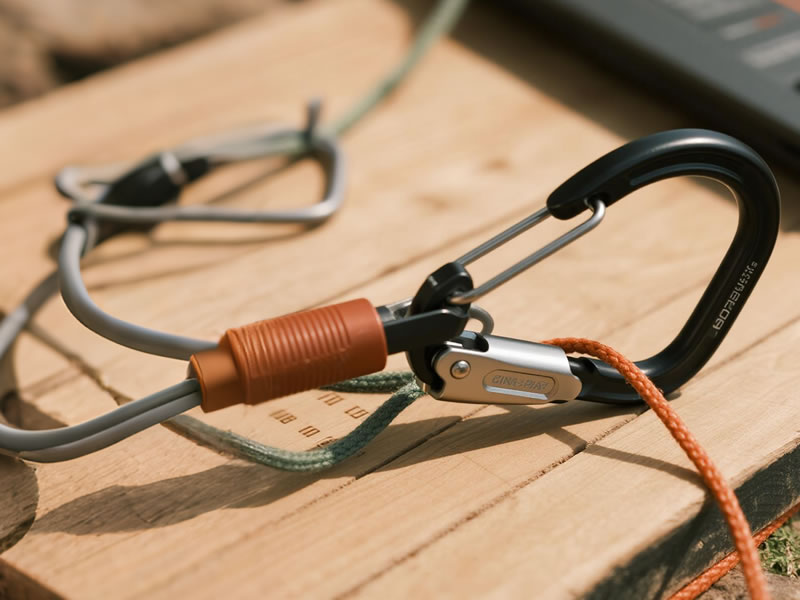Best Small Locking Carabiner: Ultimate Security for Critical Gear
When failure isn’t an option, a small locking carabiner becomes your silent guardian. Whether you’re dangling off a rock face, navigating a crowded metro, or securing high-value tools at a worksite, these compact sentinels deliver unbreakable security. Forget flimsy spring clips—true peace of mind demands engineered reliability. Here’s how to choose intelligently.

Why "Locking" Matters: Beyond Basic Clips
Standard carabiners fail catastrophically when:
- Snagged on branches or straps
- Jostled in packed bags
- Exposed to vibrations (e.g., machinery, vehicles)Locking mechanisms eliminate these risks through positive gate retention:
- Screw Locks: Threaded collars requiring 3-5 twists. Max security for climbing/industrial use.
- Twist Locks: Spring-loaded collars needing a quarter-turn. Ideal for one-handed access (EMTs, photographers).
- Double-Action Locks: Two motions to open (e.g., push + twist). Childproof security for gear.
Top 5 Performance Metrics for Professionals
- Strength CertificationsUIAA/CE: Mandatory for climbing (≥22kN gate strength).ANSI: Critical for rescue/industrial (tested to 5,000 lbs).
- Material Integrity7075 Aluminum: Harder than standard 6061, withstands impacts.Hot-Forged Steel: For corrosive environments (marine, chemical plants).
- Gate ActionSmooth thumb operation with gloves (test in freezing temps).Zero gate wiggle under load (prevents microfractures).
- Weight-to-Strength RatioTarget: ≤50g with ≥23kN strength (e.g., Black Diamond Magnetron).
- Corrosion ResistanceType III anodizing > standard coating (salt-spray tested).
Real-World Use Cases: Where Locking Carabiners Save Lives
| Scenario | Lock Type | Critical Feature |
|---|---|---|
| Rock Climbing | Screw Lock | UIAA certification, keylock nose |
| Fire/Rescue | Double-Action | One-handed operation, high-vis |
| Industrial Rigging | Twist Lock | Galvanized steel, 30kN+ rating |
| Urban EDC | Magnetic Lock | Snag-free, silent operation |
| Travel Security | Screw Lock | TSA-compliant (non-weapon design) |
The Deadly Sins of Cheap Locking Carabiners
⚠️ "Fake Locks": Collars that spin freely under vibration.
⚠️ Stress Fractures: Cast (not forged) aluminum at gate hinge.
⚠️ Corrosion Traps: Unsealed pivot points collecting moisture.
⚠️ Self-Unscrewing: Poor thread tolerances in screw locks.
Always demand test reports from manufacturers.
Pro Maintenance: Extend Lifespan by 300%
- Monthly Inspection: Check for gate stickiness, thread debris.
- Deep Clean: Soak in distilled vinegar (remove salt), rinse, dry.
- Lubricate Sparingly: Apply dry Teflon spray (not oil) to pivots.
- Retire Immediately if:Gate takes >5 seconds to openVisible gate deformationFalls exceeding 6ft onto hard surfaces
Top 3 Industry Leaders Compared
- Petzl Spirit Screw LockBest For: Alpine climbingKey Tech: H-shaped profile (30kN), I-beam spine.
- DMM Shadow LockBest For: Saltwater environmentsKey Tech: Dual-stage lock, stainless steel.
- Black Diamond MagnetronBest For: One-handed winter opsKey Tech: Magnetic auto-lock, no threads.
The Hidden Cost of Compromise
A $5 knockoff fails at 8kN (not 22kN). When loaded with 15lbs of keys, its *actual strength drops 60% due to cross-loading*. Your $200 phone shatters. Worse—a dropped carabiner triggers a rockfall below. Premium locking carabiners aren’t accessories; they’re insurance policies with 100% claim success rates.
Final Verdict: Invest in certified, activity-specific locks. Clip critical gear only to carabiners meeting UIAA/ANSI standards. Your gear—and those below you—depend on it.
Upgrade Your Security: Audit your carabiners TODAY using the criteria above. Replace any showing wear, uncertainty, or uncertified origins.






